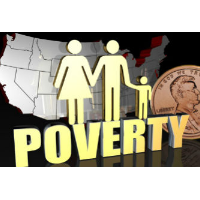California Sinks to Dead Last in Alternative Census Bureau Measure of Poverty

Californians are poor. Poorer than New Yorkers in the East, Oregonians in the West, Georgians in the South and even those perennial doormats, denizens of D.C.
In fact, California is the poorest state in the nation based on alternative figures provided by the U.S. Census Bureau that take into account a state’s cost of living among other factors. That pushes California up 7.3 percentage points in the measure of how many people live in poverty and makes it the clear winner over the District of Columbia.
California ranked in the middle of the pack using the standard measure of poverty. The national average is 15.1%; California checked in at 16.5% and was by far the state most impacted by the new measure.
When alternative considerations are factored in, the Golden State rockets to 23.8%. That’s a slight uptick from 23.5% last year. D.C. is second at 22.7%, followed by Nevada (19.8%), Florida (19.5%), Arizona (18.8%), Louisiana (18.5%), Georgia (18.2%), New York (18.1%), Hawaii (17.3%) and Texas (16.4%). The national average using the alternative method of calculation is 16%.
Iowa, at 8.6%, has the lowest percentage of people living in poverty using the new calculation. North Dakota and Wyoming are tied at 9.2%, followed by Minnesota (9.7%), Nebraska (9.8%), Vermont (10.1%), New Hampshire (10.2%), South Dakota (10.6%), Wisconsin (10.8%) and Maine (11.2%).
The numbers are important because they are used in calculating eligibility and benefits in a wide range of state and federal programs. The Census bureau has published the alternative calculations since 2011, but for now, the method conceived in the 1960s is used, mostly to California’s detriment.
Federal officials have known for decades that calculations of poverty were woefully lacking and in 1990 Congress finally appropriated money to find a better way of doing it. The National Academy of Sciences released a report in 1995 proposing that an alternative calculation be used but it took 15 years before the government got serious about developing and implementing it. The Supplemental Poverty Measure (SPM) was proposed in 2010. It factored in the cost of living, income from existing government benefits and mandatory expenses like taxes and child support.
SPM also changed basic poverty measure concepts about what constitutes income, a household and poverty thresholds. Using these factors, the Census bureau determined that the nation’s poverty rate remained unchanged between 2011 and 2012.
Thirteen states, including California, fared worse using SPM, 28 improved and the others were statistically no different. Child poverty rates decline using SPM, but they are still higher than those aged 18-64 or 65 and older. People 65+ fared worse under SPM.
All racial groups fare better under SPM except for African-Americans, whose poverty rate slips from 25.8% to 27.3%.
The bottom line is that 2.8 million more Americans probably live in poverty than the widely assumed 47 million. That includes the 2.7 million Californians living in poverty who weren’t among the 6.2 million counted by conventional means.
–Ken Broder
To Learn More:
California Still Has Highest Poverty Rate under New Method (by Dan Walters, Sacramento Bee)
California Tops Alternate Poverty Measure (by Elizabeth Aguilera, U-T San Diego)
California Poorer than Previously Thought, Census Says (by Brenda Gazzar, Los Angeles Daily News)
New Federal Poverty Measure Puts California at the Bottom (by Ken Broder, AllGov California)
Supplemental Measure of Poverty Remains Unchanged (U.S. Census Bureau)
- Top Stories
- Controversies
- Where is the Money Going?
- California and the Nation
- Appointments and Resignations
- Unusual News
- Latest News
- California Forbids U.S. Immigration Agents from Pretending to be Police
- California Lawmakers Urged to Strip “Self-Dealing” Tax Board of Its Duties
- Big Oil’s Grip on California
- Santa Cruz Police See Homeland Security Betrayal in Use of Gang Roundup as Cover for Immigration Raid
- Oil Companies Face Deadline to Stop Polluting California Groundwater





